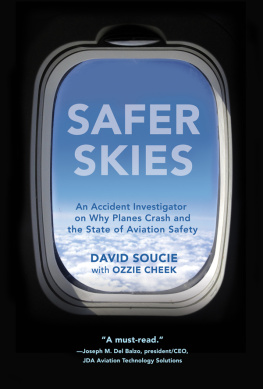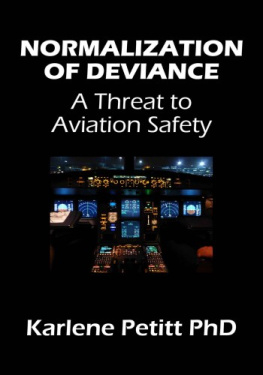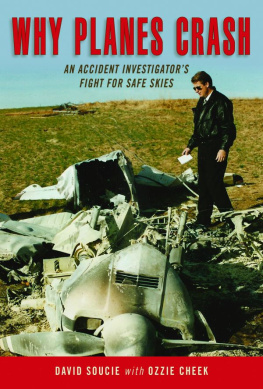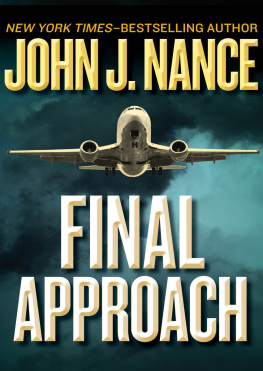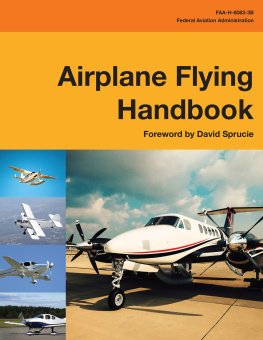Copyright 2011 by David Soucie
New materials 2015 by David Soucie
Previously published by Skyhorse Publishing as Why Planes Crash 2011
All rights reserved. No part of this book may be reproduced in any manner without the express written consent of the publisher, except in the case of brief excerpts in critical reviews or articles. All inquiries should be addressed to Skyhorse Publishing, 307 West 36th Street, 11th Floor, New York, NY 10018.
Skyhorse Publishing books may be purchased in bulk at special discounts for sales promotion, corporate gifts, fund-raising, or educational purposes. Special editions can also be created to specifications. For details, contact the Special Sales Department, Skyhorse Publishing, 307 West 36th Street, 11th Floor, New York, NY 10018 or .
Skyhorse and Skyhorse Publishing are registered trademarks of Skyhorse Publishing, Inc., a Delaware corporation.
www.skyhorsepublishing.com
10 9 8 7 6 5 4 3 2
Library of Congress Cataloging-in-Publication Data is available on file.
Print ISBN: 978-1-63220-589-6
Ebook ISBN: 978-1-63450-016-6
Printed in the United States of America
NOTE : The names and other identifying details of some people and companies in this book have been fictionalized. All fictionalized names are marked with an asterisk at the first reference. Some people have asked that I not reveal their names. Sometimes the character is minor, and Ive forgotten the real name. Some names have been changed to protect the safety and well-being of my family. This book is a memoir of my life, but some sequences and events have been condensed or changed to fit the constraints of the editing process.
Childhood drawing by my son, Tyler
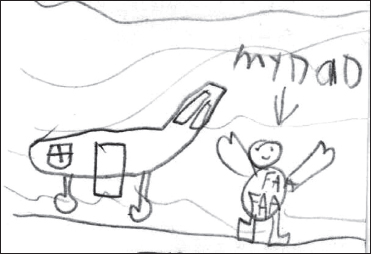
I dedicate this book to my lovely bride, who truly knows my heart; and to my loving son, who truly knows my spirit.
Contents
Introduction
D o you fear flying? You are not alone.
According to the National Institute of Mental Health, 6.5% of Americans have a fear of flying so severe that it qualifies as a phobia or anxiety disorder. A July 2007 article in The New York Times about the fear of flying noted that 40% of the people have some degree of anxiety about flying. The same article noted an international fear of-flying-conference held in Montreal that year, organized by Dr. Lucas van Gerwen, an aviation psychologist and professional pilot in the Netherlands, reported lower-than-expected attendance. Why? Many did not want to fly to the fear-of-flying conference.
If the frequency of airline crashes is the basis for a fear of flying, 2014 should prove to have a great increase in strictly earthbound travelers. Yet, this does not appear that this will be the case.
Air travel in both the United States and Europe has increased in every category. We have short memories. Even the most tragic disasters, like the disappearance of Malaysia Flight 370 and the shooting down of Malaysia Flight MC17, quickly fade in our memories. Fortunately for those who fear flying, yet must fly to earn their living, the memories do fade. It is selective memory that culls out the disturbing reality of disastrous loss of life.
For safety regulators and airline managers and owners, the memories do not fade, and that is how it should be. They must be hypervigilant about using past accidents as lessons learned in order to do everything in their power to prevent future accidents. Since this book was originally published three years ago, there have been a vast number of safety improvements by airlines, including improvements in technology and safety procedures and systems and better communication and sharing of information.
According to Aviation Safety Network, an organization that tracks aviation statistics, 2012 was the safest year since 1946 for commercial aviation deaths worldwide. Then came 2013, and it was a safer year for commercial aviation deaths worldwidethe safest year since 1946. While United States commercial airlines have continued to maintain exemplary safety records, 1,253 lives have been lost to tragic aircraft accidents worldwide thus far in 2014. News of these tragic accidents brings back those faded memories, so those who fear flyingaviophobicshave additional fodder to stoke their fears.
Those who are concerned with airline safety can never rest. I will forever ask myself what can be done to make the skies safer. In the business of airlines safety, you never know what you did rightyou only know when you did something wrong.
CHAPTER ONE
Bird on a Wire
F rom across the room, I could see Jills smile through the Christmas tree tinsel. She was reading A Christmas Carol to our son, Tyler. Her eyes met mine, and her smile disappeared. After five years of marriage, she knew when something was wrong. David, she said, are you okay?
I dropped the telephone receiver on the floor and fell to my knees. Tears filled my eyes.
Jill tossed the book aside and rose from her chair near the fireplace. Youre scaring me, sweetie, she said. What is it? I looked at her, but I couldnt speak. She hurried over and knelt beside me. Breathe! she yelled. Youre not breathing, David!
I gasped for air. They went down. Mike and them. Mike Myers hit a wire and now... oh god!
Who else? Jill asked desperately, while hugging me. Who was with him? Jill knew Mike and his family, as well as the flight nurses and the crew in Grand Junction, Colorado.
I dont know. Some patients, I think. A nurse. They may all be dead. Thats when the truth smacked me full force. Mike had crashed after hitting a power line or telephone wires because the helicopter was not equipped with a wire-strike kit, a safety addition that I had refused to add. I think its my fault, I said, feeling numb. Its my fault they went down.
Dont be silly, she said. I heard a faint voice coming from the phone on the floor, but I couldnt bring myself to touch it. Are you going to pick it up? Jill asked. I shook my head no, so she picked up the receiver and listened to whatever else Roy Morgan was saying. Okay, Roy, I heard her say. Were leaving now.
My brain processed only the simplest parts. Leaving? Check! Meeting Roy? Check! Roy Morgan owned Air Methods Inc., the emergency medical helicopter company where I worked. I was twenty-six years old and already the senior director of maintenance. Mike Myers was one of our pilots. He flew helicopters that I was responsible for maintaining.
While I bounced between despair and disbelief, Jill bustled around. We had a child to care for. We had to get to Arapahoe County airport to meet Roy Morgan so we could fly to Grand Junction right away. I had to go see Mike Myers. I had to fix things. Fix things? Check!
Jill grabbed coats and car keys. Dave, she said from the door, you ready? I realized at that moment that whatever I would do in life that was worthwhile would be because of Jills steady presence. I nodded, looked one last time at the glowing tree, and followed her out.
It was Christmas Eve 1985.
The December weather was bone-chilling cold in the West. An ice storm had turned the highways into asphalt skating rinks, and while weather conditions made night flying more dangerous than usual, flying was faster and safer than using the highways. Besides, pilot Mike Myers was highly experienced on the Bell 206 helicopter. Thats why he was transporting two young flight nurses, Debbie Carrington* and Deana Smith*, to a remote region near Monticello, Utah, to assist a pregnant woman with a premature birth.

